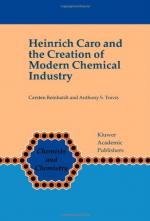|
This section contains 288 words (approx. 1 page at 300 words per page) |
World of Invention on Heinrich Caro
Caro was born in Posen, Prussia (now Poznan, Poland) in 1834. He moved to Berlin in 1834 and eventually studied dyeing at the Gewerbeinstitut and chemistry at the University of Berlin. In 1855 a calico factory hired Caro as a colorist. There he was able to apply his chemical training to solve production problems, and he was soon sent to England for training in more advanced dyeing processes. He studied there for two years, returning to Germany to work with synthetic dyes, which were growing in popularity, for Roberts, Dale and Company.
Caro was able to build on the work of others to discover improved processes. He enhanced William Henry Perkin's technique for deriving mauve dye from aniline and was made a partner in the firm. His work on induline was built on the Johann Peter Griess's (1829-1888) work with aniline dye. Caro also worked with C. A. Martius to produce Bismarck brown and Martius yellow. Caro's research helped to define the structure of triphenylmethane, the parent compound of rosaniline dyes.
In 1866 Caro moved back to Berlin, where he soon became the director of the Badische Anilin und Soda Fabrik (BASF) laboratory. Caro improved the technique of Carl Graebe (1841-1927) and Liebermann to produce alizarin. He added bromine to Adolf von Baeyer's flourescein and produced flourescent red. In collaboration with Baeyer, Caro developed the dye known as methylene blue. In the mid 1870s numerous azo dyes were developed and discovered. Caro, with others, developed chrysoidine, orange and fast red. He went on to discover naphthol yellow, persulfuric acid, also called Caro's acid. Caro resigned from BASF in 1889. Heinrich Caro was responsible for more of Germany's successes in the dye industry than any other individual. He died in Dresden in 1910.
|
This section contains 288 words (approx. 1 page at 300 words per page) |


